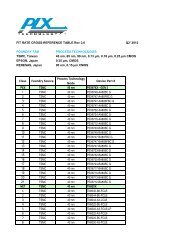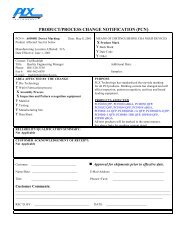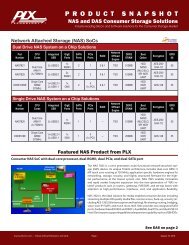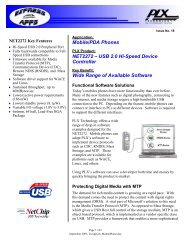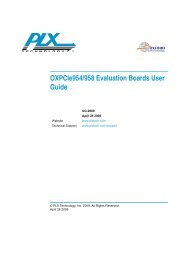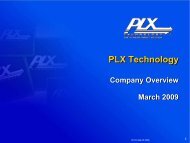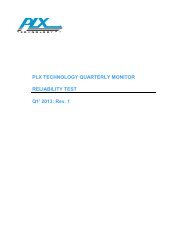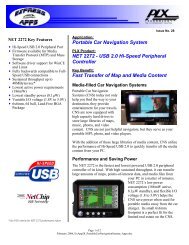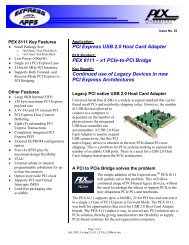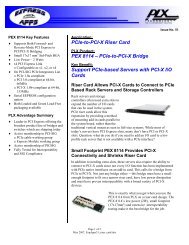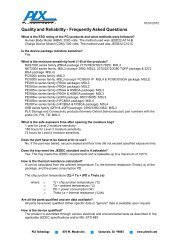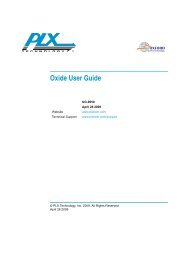the 2009 Annual Report (pdf) - PLX Technology
the 2009 Annual Report (pdf) - PLX Technology
the 2009 Annual Report (pdf) - PLX Technology
You also want an ePaper? Increase the reach of your titles
YUMPU automatically turns print PDFs into web optimized ePapers that Google loves.
every six months in exchange for o<strong>the</strong>r <strong>PLX</strong> products of equal value. We analyze current stock rotation requests and<br />
past experience, which has historically been insignificant, to determine <strong>the</strong> ending sales reserve required for this<br />
program. In addition, we have arrangements with a small number of customers offering a rebate program on various<br />
products. We record rebates as a reduction of revenue when <strong>the</strong> rebate is in <strong>the</strong> form of cash consideration or a<br />
reduction to accounts receivable. Reserves are reduced directly from revenue and recorded as a reduction to accounts<br />
receivable.<br />
Inventory Valuation. We evaluate <strong>the</strong> need for potential inventory provisions by considering a combination of<br />
factors, including <strong>the</strong> life of <strong>the</strong> product, sales history, obsolescence, and sales forecast. Any adverse changes to our<br />
future product demand may result in increased provisions, resulting in decreased gross margin. In addition, future<br />
sales on any of our previously written down inventory may result in increased gross margin in <strong>the</strong> period of sale.<br />
Allowance for Doubtful Accounts. We evaluate <strong>the</strong> collectability of our accounts receivable based on length of<br />
time <strong>the</strong> receivables are past due. Generally, our customers have between thirty days to forty five days to remit<br />
payment of invoices. We record reserves for bad debts against amounts due to reduce <strong>the</strong> net recognized receivable to<br />
<strong>the</strong> amount we reasonably believe will be collected. Once we have exhausted collection efforts, we will reduce <strong>the</strong><br />
related accounts receivable against <strong>the</strong> allowance established for that receivable. We have certain customers with<br />
individually large amounts due at any given balance sheet date. Any unanticipated change in one of those customers’<br />
creditworthiness or o<strong>the</strong>r matters affecting <strong>the</strong> collectability of amounts due from such customers could have a<br />
material affect on our results of operations in <strong>the</strong> period in which such changes or events occur. Historically, our<br />
write-offs have been insignificant. However, due to <strong>the</strong> current economic conditions, our customers may encounter<br />
liquidity issues leading to additional bad debt expense.<br />
Goodwill. Our methodology for allocating <strong>the</strong> purchase price related to business acquisitions is determined<br />
through established valuation techniques. Goodwill is measured as <strong>the</strong> excess of <strong>the</strong> cost of <strong>the</strong> acquisition over <strong>the</strong><br />
amounts assigned to identifiable tangible and intangible assets acquired less assumed liabilities. We have one<br />
operating segment and business reporting unit, <strong>the</strong> sales of semiconductor devices, and we perform goodwill<br />
impairment tests annually during <strong>the</strong> fourth quarter and between annual tests in certain circumstances. In 2008, we<br />
determined that our carrying value exceeded fair value, indicating that goodwill was potentially impaired. As a result,<br />
we initiated <strong>the</strong> second step of <strong>the</strong> goodwill impairment test which involves calculating <strong>the</strong> implied fair value of<br />
goodwill by allocating <strong>the</strong> fair value of <strong>the</strong> Company to all of our assets and liabilities o<strong>the</strong>r than goodwill and<br />
comparing it to <strong>the</strong> carrying amount of goodwill. We determined that <strong>the</strong>re was no implied fair value of goodwill and<br />
recorded an impairment charge of $34.7 million in 2008. In <strong>the</strong> fourth quarter of <strong>2009</strong>, we tested <strong>the</strong> goodwill<br />
acquired in <strong>the</strong> acquisition of Oxford in <strong>2009</strong> and determined <strong>the</strong>re was no impairment.<br />
Long-lived Assets. We review long-lived assets, principally property and equipment and identifiable intangibles,<br />
for impairment whenever events or circumstances indicate that <strong>the</strong> carrying amount of assets may not be recoverable.<br />
We evaluate recoverability of assets to be held and used by comparing <strong>the</strong> carrying amount of an asset to estimated<br />
future net undiscounted cash flows generated by <strong>the</strong> asset. If such assets are considered to be impaired, <strong>the</strong><br />
impairment recognized is measured as <strong>the</strong> amount by which <strong>the</strong> carrying amount of <strong>the</strong> assets exceeds <strong>the</strong> fair value<br />
of <strong>the</strong> assets. Also see Note 6 to <strong>the</strong> consolidated financial statements. During 2008, as a result of <strong>the</strong> goodwill<br />
impairment testing, we had to evaluate our o<strong>the</strong>r long-lived assets for impairment. We purchased our headquarters<br />
building in 2000. It is ideal for our operations and have no plans to relocate or sell <strong>the</strong> building. However, due to <strong>the</strong><br />
decline in <strong>the</strong> value of commercial property, <strong>the</strong> building was appraised for $18.8 million less than its carrying value,<br />
which was recorded as an impairment charge in 2008.<br />
Taxes. We account for income taxes using <strong>the</strong> asset and liability method. Deferred taxes are determined based on<br />
<strong>the</strong> differences between <strong>the</strong> financial statement and tax bases of assets and liabilities, using enacted tax rates in effect<br />
for <strong>the</strong> year in which <strong>the</strong> differences are expected to reverse. Valuation allowances are established when necessary to<br />
reduce deferred tax assets to <strong>the</strong> amounts expected to be realized. As of December 31, <strong>2009</strong>, we carried a valuation<br />
allowance for <strong>the</strong> entire deferred tax asset as a result of uncertainties regarding <strong>the</strong> realization of <strong>the</strong> asset balance<br />
(see Note 12 to <strong>the</strong> consolidated financial statements). The net deferred tax assets are reduced by a valuation<br />
allowance if, based upon weighted available evidence, it is more likely than not that some or all of <strong>the</strong> deferred tax<br />
assets will not be realized. We must make significant judgments to determine our provision for income taxes, our<br />
deferred tax assets and liabilities and any valuation allowance to be recorded against our net deferred tax asset. As of<br />
December 31, <strong>2009</strong>, a valuation allowance continues to be recorded for <strong>the</strong> deferred tax assets based on<br />
31




